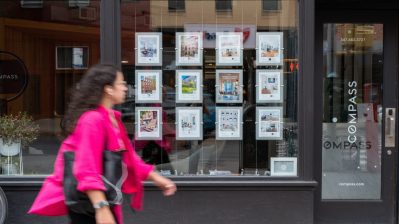Threadless designs success with crowd-sourced business model
Threadless designs success with crowd-sourced business model
TEXT OF INTERVIEW
KAI RYSSDAL: The T-shirt company Threadless has been around for 10 years now. In that time it’s sold about four million shirts with what was when it started, and still is now, a somewhat unconventional business model. It gets outsiders to come up with designs, strangers pick the best ones, and then the company sells those winners. It’s crowd-sourcing at its economic best.
Founder and one-time CEO Jake Nickell has a new book out about the first 10 years of Threadless called, “Threadless.” The story of the company and 10 years worth of great T-shirt designs, which I should say before we start you can see here. Jake, good to talk to you.
JAKE NICKELL: Thanks for having me.
RYSSDAL: Where’d the idea for this company come from? You’re 20 years old, you’re an art student, and all of a sudden you’re making T-shirts?
NICKELL: Yeah, I was going to art school, but I was also working a full-time job as a web developer. And I was a member of an art community online and my contribution to the community was that if you put T-shirt designs up on the forum, I would print the best ones.
RYSSDAL: Explain how it works for those who might not know.
NICKELL: An artist submits a design. It gets scored by our community of about 1.5 million people and the top scoring designs we actually print and sell. We pay the artist $2,000 and a $500 gift certificate and then royalties on reprint fees. And we come out with six to nine new designs every single week. Last year we paid over $1.5 million out to artists.
RYSSDAL: So the business term, the nomenclature for this, is crowd-sourcing, right? You go out and you get these people to submit and then you crowd-source the evaluation. Did that come organically from your start in that online art community?
NICKELL: Yeah, the term crowd-sourcing was coined, I believe, in 2004 by a guy named Jeff Howe, who was an editor for Wired Magazine and that was four years into us doing business, and we’ve become kind of the poster child for crowd-sourcing. And there’s a lot of interesting crowd-sourcing companies that have started up very recently. It’s become a very popular business model. But really what we were about is just community-based design, like collaborating as artists. And I think what crowd-sourcing is kind of turning into is where people are doing work for companies, like designing logos or things that are not so personal. It’s more like work that a company needs done that they’re outsourcing to a crowd of anonymous people.
RYSSDAL: That dynamic that you guys had, I mean you had the typical start-up dynamic. If you look at the pictures in this book, it’s the big warehouse space with, you know, the foosball table and a gaming chest and all that. I mean, you had that. And now 10 years later, you’ve got 100 employees shipping stuff all over the world.
NICKELL: Yeah, and we still do crazy stuff. Half our employees are in our warehouse. And just last week, we had a live band play in our warehouse while people were picking orders. We had a DJ, Martin Atkins, come in who used to be the drummer of Ministry. It’s just part of our culture.
RYSSDAL: There must have been, in the past 10 years, a couple of moments, as you felt your way around this start-up that you had of, ‘Man, if only I knew back then what I know now.’ What were the decision points that turned Threadless from this hobby that you had into a thriving, viable business?
NICKELL: I think that actually not knowing anything was more valuable in growing Threadless than knowing something. And I kind of feel like if I did know the way things were supposed to get done, Threadless wouldn’t have happened.
RYSSDAL: Where do you go now? I mean, what’s next beyond T-shirts? Or are you happy just doing art and T-shirts?
NICKELL: Well T-shirts were just such an easy canvas. Every small town in America has a T-shirt printer. But now, we’re starting to do a lot of partnerships where we’re realizing that our strength as a company isn’t in making T-shirts, it’s in this global art community and we’re feeling like we could do so much more than just make T-shirts with all these artists. Looking back at the past year, we’ve done a lot of partnerships with Griffin, we’ve made iPhone cases, we’ve made flip flops with Havianas, we’ve made laptop covers with Dell.
RYSSDAL: Yeah, it could be anything, right?
NICKELL: Yeah, I was joking around that you could design the frosting that goes on donuts at Dunkin’ Donuts. It’s ridiculous how it could be anything.
RYSSDAL: All right. That, I think, is jumping the shark.
NICKELL: Yeah, that’s too much maybe.
RYSSDAL: Jake Nickell is the founder — he was also the CEO for a long time — of Threadless. He’s got a book out about the company’s first 10 years. It is called “Threadless.” And we have got some of those designs, you’re going to want to check them out. There’s some pretty interesting T-shirts out there. Jake, thanks a lot.
NICKELL: Yeah, thank you. I had a lot of fun.
There’s a lot happening in the world. Through it all, Marketplace is here for you.
You rely on Marketplace to break down the world’s events and tell you how it affects you in a fact-based, approachable way. We rely on your financial support to keep making that possible.
Your donation today powers the independent journalism that you rely on. For just $5/month, you can help sustain Marketplace so we can keep reporting on the things that matter to you.


















